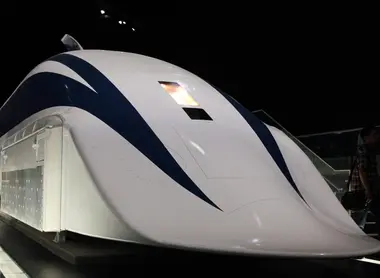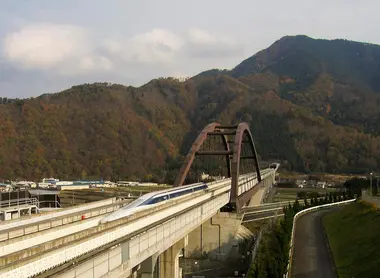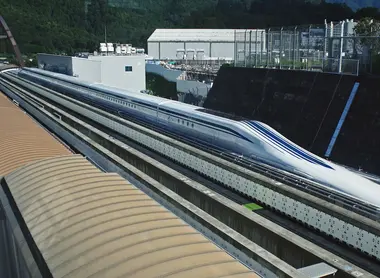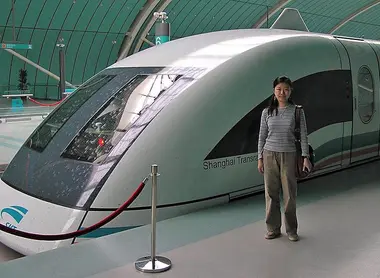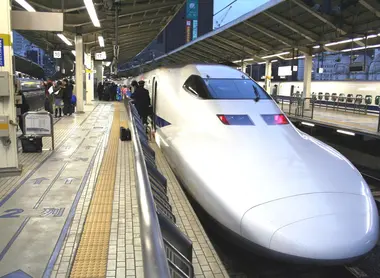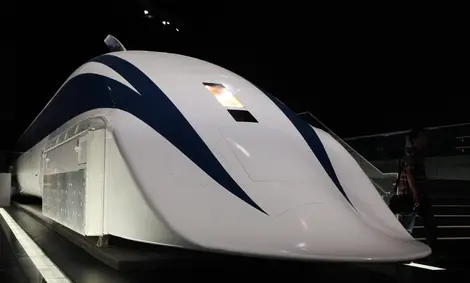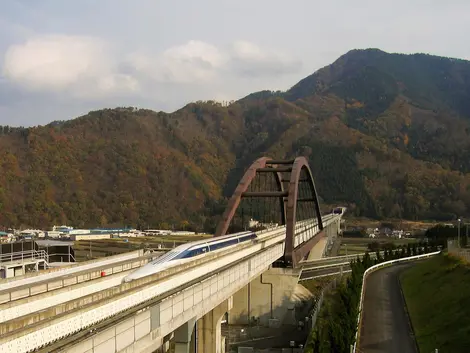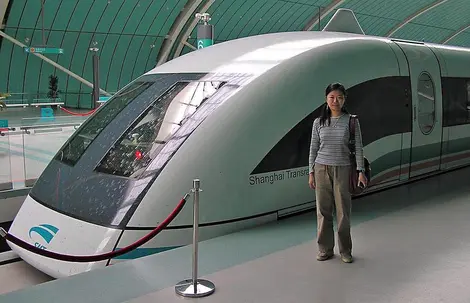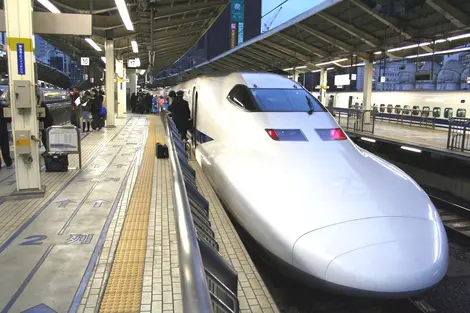Maglev: the future magnetic levitation train
- Published on : 22/06/2017
- by : J.L.
- Youtube
When the train catches up with the plane
The magnetic levitation train, or Maglev, represents a revolution in the railway world. This technology enables trains to literally "fly" above the rails thanks to electromagnetic forces, eliminating rolling resistance and reaching extraordinary speeds - up to 603 km/h, a record set in Japan in 2015. For over a century, this technology has fascinated engineers, but its commercial development remains limited, with only a few lines in service worldwide. Faced with the challenges of fast, ecological and efficient mobility in the 21st century, could Maglev become the rail transport of the future? Between technical prowess, infrastructure costs and energy challenges, let's explore this revolutionary mode of transport that pushes the limits of speed.
The technological principles of magnetic levitation
Maglev, short for "SuperconductingMagneticLevitation" in Japan, is an electromagnetically levitated monorail system that ensures the train is not in direct contact with the rails. Unlike conventional trains, it levitates thanks to physical principles based on magnetic forces. There are two main magnetic levitation technologies.
The first, called electromagnetic levitation (EMS), uses electromagnets in the train to attract it to a magnetically conductive track. The train wraps around the track, and electromagnets attached to the underside of the vehicle point upwards to lift it. This technology enables trains to levitate at all speeds, even when stationary, but requires sophisticated feedback systems to maintain a constant distance of around 15 mm from the track.
The second, electrodynamic levitation (EDS), uses superconducting electromagnets or permanent magnets to create a magnetic field that induces currents in the metal conductors of the track. This is the method employed by Japan's SCMaglev, which uses superconducting coils maintained at around -269°C by a circuit of liquid nitrogen and liquid helium. This technology is more stable, but only works above a certain speed, requiring wheels for low-speed travel.
Maglev history and development: from early experiments to commercial lines
The history of maglev trains began in the early 20th century. In 1912, the Franco-American Émile Bachelet obtained a patent for his "levitation transmission apparatus", and in 1914 presented the first demonstration model of a magnetic levitation train in London. Research continued with the German Hermann Kemper, who obtained a patent in 1934, but his work was interrupted by the Second World War.
In 1962, Japan embarked on in-depth Maglev research. A first test line was built in Miyazaki Prefecture in 1977, followed by a second, almost 50 km long, in Yamanashi Prefecture, near Mount Fuji, in 1992. This line enabled numerous tests to be carried out, setting a first world speed record of 581 km/h in 2003.
In Germany, research resumed in 1973 at the Technical University of Brunswick. In 1979, the Transrapid 05 became the world's first magnetic levitation train to carry passengers at an exhibition in Hamburg. Germany then developed a test line in the Emsland region in 1984, but after the Lathen accident in 2006, which killed 23 people, the project was definitively abandoned in 2008.
In 2015, the Japanese Maglev set a new world record at 603 km/h with passengers on board, surpassing the record set by the French TGV (574.8 km/h). These performances demonstrate the extraordinary potential of this technology, which continues to evolve despite technical and economic challenges.
State of play: Maglev lines in service around the world
After nearly sixty years of research and testing, only a handful of Maglev lines are currently in commercial service worldwide, with a cumulative length of around 74 km. The most famous is undoubtedly Shanghai's Transrapid, a 30 km city-airport link inaugurated in January 2004. With a top speed of 431 km/h, this train covers the distance in just 7 minutes and 20 seconds, making it the first and only high-speed magnetic levitation train in regular commercial use.
In Japan, the Linimo line, 8.9 km long in Aichi, went into service in 2005. With a maximum speed of 100 km/h, it offers an innovative urban transport solution, but falls well short of the performance of China's Transrapid.
South Korea also has two Maglev lines: a one-kilometer line to the Daejeon exhibition center, and since 2016, a 6.1-km line linking Yongyu station to Incheon airport.
In addition to the Shanghai Transrapid, China has developed several other Maglev lines. The Changsha Maglev express line, in service since 2016, links Changsha-Sud station to Changsha-Huanghua international airport over 18.6 km. More recently, the S1 line of the Beijing metro has been operating over 10.2 km in the west of the Chinese capital since 2017.
These achievements, though limited in number, demonstrate the commercial viability of this technology, particularly for airport-city-center links or urban transport applications.
Future projects: China, Japan and other international initiatives
The most ambitious project currently under development is undoubtedly Japan's Shinkansen Chūō line. This project will link Tokyo-Nagoya (286 km) in 40 minutes, at a commercial speed of 505 km/h. Work is underway and the opening, originally scheduled for 2027, has been postponed to 2034. The line will then be extended to Osaka by 2037, making it possible to cover the 438 km between Tokyo and Osaka in just 1h07.
The Maglev train will serve stations in Shinagawa (Tokyo), Kofu, the Southern Japanese Alps, Nagoya, Nara and Osaka. This titanic project, 80% of which will be underground, represents a colossal investment of over 70 billion euros. It will relieve the already saturated conventional Tokaido Shinkansen.
China also has great ambitions for Maglev. In its 2023-2035 transport plan, the municipality of Guangzhou has announced several long-distance Maglev lines, notably between Guangzhou and Beijing (3h30 journey time, compared with 7h30 today) and between Guangzhou and Shanghai (3h, compared with 7h today). These trains are expected to travel at speeds of at least 600 km/h. China has even carried out a tunnel test reaching 1,000 km/h on a 2-kilometer section.
Other initiatives are underway around the world. Since 2017, the Polish company Nevomo has been developing a technology for adapting conventional tracks to magnetic levitation. Their "MagRail" system could enable speeds of 550 km/h to be reached on existing TGV lines. A first successful test was carried out in September 2023, and a partnership was signed with SNCF in March 2023 to evaluate the technology.
In the USA, JR Central and Northeast Maglev are working on a project for a line between Washington D.C. and New York, with the first section between D.C. and Baltimore estimated at $10 billion. If built, the train would reduce travel time between these two cities from three hours to one hour.
Advantages and disadvantages of Maglev over conventional trains
Maglev trains offer a number of significant advantages over conventional trains. Firstly, the absence of physical contact between the train and the track eliminates rolling resistance, enabling much higher speeds to be reached. This technology also offers better acceleration and greater gradient-crossing capabilities (up to 40‰), limiting the number of tunnels and engineering structures required.
In terms of safety, the risk of derailment is virtually nil in constructions like the Transrapid, thanks to the train's track envelopment system. Passenger comfort is also enhanced, with less vibration and noise. In fact, since the main source of noise comes from displaced air rather than wheel/rail contact, Maglev trains are generally quieter than conventional trains at equivalent speeds.
In terms of maintenance, Maglev tracks require less upkeep than conventional rails, which are subject to considerable mechanical wear, especially at high speeds. Vehicle maintenance is also reduced, based on operating hours rather than speed or distance covered.
However, this technology also has major drawbacks. The most critical is incompatibility with existing rail networks: a Maglev train requires specific infrastructure and cannot use conventional tracks, unlike TGVs which can run on the conventional network, even at reduced speed.
Infrastructure costs are extremely high, especially for electrodynamic levitation systems, which use expensive superconducting magnets. Energy consumption is also significant, particularly at low speeds where levitation can consume up to 15% more energy than a metro or light rail system.
Finally, some Maglev systems, notably the Japanese type SCMaglev, generate strong magnetic fields that could affect people with pacemakers or magnetic storage media, necessitating the use of magnetic shielding.
The economic and technical challenges of Maglev implementation
Large-scale implementation of Maglev trains faces several major challenges, the first of which is undeniably the prohibitive cost of infrastructure. The Japanese Chuo Shinkansen project is a perfect illustration of this problem: initially estimated at 5.52 trillion yen (42.5 billion euros) for the Tokyo-Nagoya section, its cost has already been re-evaluated at 7.04 trillion yen (70 billion euros). These colossal investments are difficult to justify economically, particularly in a post-pandemic context where business travel needs could be permanently altered.
From a technical point of view, the constraints are also considerable. Maglev lines require extremely straight layouts with very wide curve radii to maintain high speeds. In the case of the Japanese project, this means that 86% of the Tokyo-Nagoya line will be underground, with stations located up to 40 meters below ground, adding to the costs and technical challenges.
Energy consumption is another major challenge. According to some estimates, Japan's Maglev will consume three to five times more energy than conventional Shinkansen, which raises questions in the context of the energy transition. At peak times, the Chuo Shinkansen line would require 270,000 kW of electricity for a maximum travel speed only 1.7 times that of ordinary Shinkansen trains.
Environmental constraints also give cause for concern. In Japan, construction of the Maglev tunnels is raising concerns about groundwater flow. The example of Shizuoka prefecture is revealing: local authorities are opposed to the project because a tunnel could reduce the flow of the Oigawa River by two tonnes of water per second, threatening local agriculture.
Finally, thesocial acceptability of these projects is not guaranteed. In Japan, many residents are being forced to move to make way for the new train. In Sagamihara, Kanagawa Prefecture, 85% of residents surveyed said they were opposed to the project, despite the compensation offered.
Future prospects: vacuum tubes and next-generation technologies
The future of magnetic levitation trains could lie in even more revolutionary innovations, such as vacuum tubes. This technology, proposed in particular by the now-defunct Swissmetro project and taken up again in the Hyperloop concept popularized by Elon Musk, consists of running Maglev trains in tunnels where the air is partially evacuated, drastically reducing the aerodynamic resistance that represents the main limit to speed above 150 km/h.
China is at the forefront of these developments with its Hyperloop Maglev project. In August 2024, the country successfully completed a key test in a low-pressure tube in Datong, validating system integration. The ambitious goal is to reduce the Beijing-Shanghai journey to just 90 minutes, which would require speeds well in excess of 1,000 km/h.
Other innovations include "high-temperature" superconducting magnets. The Japanese SCMaglev train has successfully completed tests using superconductivity at -196°C (the temperature of liquid nitrogen), which is easier to maintain than the -270°C of conventional superconducting magnets. These advances could significantly reduce operating costs.
Significant progress is also being made in permanent magnet technology. China's "Red Rail", tested in Jiangxi province, uses rare minerals to create magnets with a constant repulsive force. This innovation enables levitation without the need for electricity, drastically reducing energy consumption. Thanks to its mining resources, China produces 80% of these "permanent" magnets.
Another promising development is the integration ofartificial intelligence to manage train control. China plans to run the Red Rail without human intervention, with AI managing all operations, potentially improving the system's safety and efficiency.
Finally, hybrid approaches such as Nevomo's aim to create technologies that enable a gradual transition to magnetic levitation. Their "MagRail Booster" system enables existing railcars to be retrofitted with electromagnetic assistance for acceleration, without the need for full levitation.
To further explore the fascinating world of magnetic levitation trains, you can visit the Linear Museum near Yamanashi, Japan, accessible via http://linear-museum.pref.yamanashi.jp/english/index.html. This visit will give you an in-depth understanding of this revolutionary technology which, despite its challenges, could radically transform the way we travel in the 21st century.
Address, timetable & access
Address
Timetable
Open 9am to 5pm. Closed on Mondays.Price
Adults: 420 yen (3.40 euros).
Young people (aged 16 to 18): 310 yen (2.50 euros).
Children (aged 6 to 15): 200 yen (1.60 euros).
A daily draw is held for those wishing to take part in a Maglev test ride.Access
Website
http://linear-museum.pref.yamanashi.jp/english/index.html
